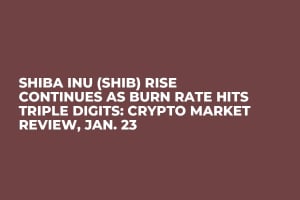
Disclaimer: The opinions expressed by our writers are their own and do not represent the views of U.Today. The financial and market information provided on U.Today is intended for informational purposes only. U.Today is not liable for any financial losses incurred while trading cryptocurrencies. Conduct your own research by contacting financial experts before making any investment decisions. We believe that all content is accurate as of the date of publication, but certain offers mentioned may no longer be available.
The burn rate of one of the biggest meme tokens on the market is on the rise once again. In the last 24 hours, more than 110 million SHIB tokens have been removed from circulation, and the overall number of burned tokens is still rising. The 700% rise occurs amid SHIB's reversal from the important resistance level.
A high burn rate on the Shiba Inu network is the result of increasing activity on the blockchain. As more users transfer, pay or utilize Shiba Inu in any way, more tokens are sent to the burn address, where they are going to stay for good.
As we have mentioned numerous times, at least a 100 million SHIB burn per day would be enough to slowly push Shiba Inu to scarcity and notably decrease the pressure on the token's market performance.
Shiba Inu's market performance
Unfortunately, the latest performance of SHIB on the market was not as desirable as it could be, as the asset could not break the three-month-old trendline resistance, which has been acting as a barrier between the up- and downtrend.
The reversal most likely led to the spike in the number of transactions on the network as investors most likely tried to quickly close their positions to avoid further losses caused by a potential market-wide reversal.
Luckily, Shiba Inu was not as heavily leveraged as other assets, and the 10% correction around the resistance level was not fueled by the enormous liquidation volume on the market. At press time, SHIB is changing hands at $0.000011 and may still reverse upwards, as it successfully remains above the 200-day moving average.

 Dan Burgin
Dan Burgin Vladislav Sopov
Vladislav Sopov U.Today Editorial Team
U.Today Editorial Team